MicroSensor makes various water pressure sensors with varying options of materials, pressure ranges, pressure ports, and output signals to choose from. You could even have your water pressure transmitter custom designed.
The company is a renowned supplier of water sensors and provides water pressure sensor equipment for water sinks, underground water use, and water pipes. The water pressure sensors are stable, accurate, and provide reliable pressure measurements.
Water Pressure Sensors & Transmitters
MicroSensor makes pressure sensors, transmitters and transducers that people use in various fields and industries, including environmental monitoring, hydrology, hydropower plants, and more. Visit this page for more details about their pressure transmitters. For instance, you can use water pressure sensors to monitor dams, sea water pressure and the water’s depth, control water levels, and figure out flow rates.
MicroSensor water pressure sensors can measure static water pressure in tanks, pipelines, and more. You can also use the sensors to measure underground water depth in boreholes, wells, and agricultural irrigations. The equipment allows users to deliver expertise in several fields through the extensive and accurate information the sensors provide from tanks, pipes, etc.
Water Pressure Sensors
Water pressure is a force applied to water. These are of two types dynamic and static. Static water pressure is the difference between water and atmospheric pressure in a given location. Dynamic pressure refers to the pressure exerted by water in motion, i.e., waves and water moving in pipes.
Water pressure sensors are used to measure liquid water. You can use the equipment to measure the pressure exerted by water in enclosed spaces or atmospheric pressure in open areas.
There are three measurement options when measuring water pressure: absolute, gauge, and differential.
Absolute
Absolute water pressure measurements are made against zero and are similar to analog pressure gauges. Users measure the pressure against a reference value, and the water pressure sensor isn’t affected by any pressure changes in the liquid water circuit. Users place the equipment above (and in direct contact with) the water in a liquid-tight container and measure the absolute pressure.
Gauge
We use this measurement technique to measure a liquid’s pressure about atmospheric pressure. It’s similar to a manometer and is sensitive to atmospheric pressure changes. However, you’ll only use it to measure relative pressures.
Differential
This water pressure sensor is similar to a barometer and is good for measuring water pressure differences between two points.
How Does a Water Pressure Sensor Work?
People use water pressure sensors (or water pressure transducers and transmitters) to measure water pressure in various applications, including pipelines, water tanks, and water containers. The equipment has a similar mechanism to air pressure sensors in that it has a diaphragm, a circuit board, and a transmitting component.
With a port installed in water pipes, a tank, or a container, the pressure transmitter’s diaphragm senses the water pressure and converts the information to a current signal through a circuit that enables the entire measurement. The information provided (usually in digital format) helps users determine the water’s level.
MicroSensor’s Water Monitoring Solutions
Water is the source of life and is an essential resource for life and human production. Developed and developing societies face various problems like environmental pollution and water shortages leading researchers to look for various solutions.
It’s become vital to promote transformation and upgrade traditional water resource management. Researchers are looking for smarter, newer, and more efficient solutions, technology, and equipment to solve these issues.
The environmental and water sector represents a diverse part of business, necessitating the need for effective equipment that provides valuable solutions. MicroSensor offers water monitoring solutions like:
- Water supply systems used for urban water systems: The equipment helps determine the flow of water and pressure within the pipes. It also helps determine how much water is available in the supply tanks.
- Sea water solutions like seawater desalination: You can also use water level sensors to determine the amount of water available in water storage tanks in desalination plants for more efficient processes.
- Water for environmental protection like sewage treatment: You can also use water level sensors in sewage treatment plants to determine the amount of effluent or sewage present in tanks for increased efficiency in the sewage treatment process.
- Water solutions for oil fields like oil and gas collection and water flooding: You can use water level sensors on oil fields to determine the amount of water or oil present when separating water from oil.
- Water solutions in the marine sector, like ballast tank water and drinking water: You can use water level sensors for various purposes in the marine sector. For instance, you can use the equipment to determine the amount of water in ballast tanks for efficient hydrostatic stability.

















